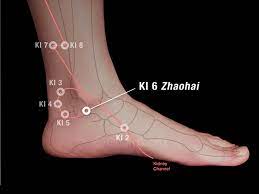
Foot Pain & Loss of Voice – Psychosomatic Symptoms Treated by Acupuncture & Herbs: A Case Study
A physical problem isn’t always just physical. I’ve come to know this both through personal experience and many years as an acupuncturist.
A patient recently came to me complaining of two main physical problems. The first was a persistent laryngitis: a scratchy throat with loss of voice. The other was a pain in the sole of his foot that was often worse in the morning after getting out of bed, but would come and go.

Acupuncture views body physiology through the acupuncture channels, of which there are 71. These channels transverse the entirety of the body, external and internal, even entering into the organs.
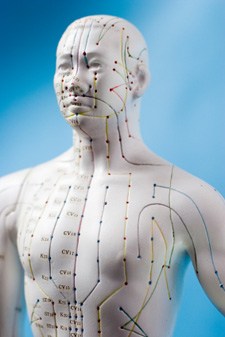
A physical problem isn’t always rooted in the area where the symptoms arise. They often come from a deeper place elsewhere in the body.
Chinese medicine is ancient, developed during a time where there was deep acknowledgement and understanding that the mind, body and spirit were linked, intertwined and either manifested symptoms of distress on all levels at once or translocated symptoms to different levels.
For example, psychosomatics is the process by which something mental-emotional manifests as a physical problem. The opposite can also be true: physical or chemical body imbalances can cause mental-emotional distress symptoms.

The exciting part to healing through a mind-body system like Chinese medicine is the amount of self-awareness and discovery that can emerge. By looking into the root of the problem rather than just the symptom, we can achieve a type of “soul-retrieval” which returns self-empowerment, and helps us to align more fully with our selves.
Of course acupuncture is masterful in alleviating symptoms of almost any type. But many people are interested in a deeper way of working on themselves that is more transformational, and even spiritual.
Acupuncture practiced in its classical method can act like bodywork to alleviate symptoms, psychotherapy to delve into the deeper realms of the mind and shamanic healing for “soul retrieval,” the removal of dark energies and resolution of trauma.
How do we assess whether a problem is a surface issue or coming from a deeper place in the mind-body? There are several ways. The first comes through the way a person speaks about themselves and their lives. As acupuncturists we try to construct a “pattern” using all of the symptoms and “signs” a patient presents to identify a particular “system” which appears out of balance.
The other ways of assessing a patient is through diagnosis of the pulse, tongue, complexion, voice quality, body odors and emotional demeanor. These “signs” often give clues and messages the patient himself might not be aware of.

The tongue acts as a reflexology picture of the internal body, showing the state of the internal organs. The pulse contains many layers where the energetic function of the body can be assessed, from the most superficial layer to the deepest.

The pulse quality that was most striking in this patient was present at the deepest level of his pulse. The pulse had a “vibrating” quality which suggests the constitution or deepest layer of the psycho-spiritual self is actively working something out.
Obviously in treatment we started with superficial, obvious methods, making sure the throat wasn’t due to a virus or bacteria. it wasn’t. Or overuse. For the foot we also tried superficial muscular treatments that had little lasting effect. It became clear these problems were not coming from the superficial layer of the body.
The pulse told me to look at the special acupuncture channel called Yin Qiao Mai: the stance vessel. This vessel is also sometimes called “the heel vessel.” The trajectory of this channel begins at the ankle and travels into the foot and sole. It also manifests its energy in the throat.

Another deep level pulse that tended to emerge for this patient was associated with the Yin Wei Mai channel: the Linking Vessel.
The Yin Qiao and Yin Wei vessels are both classified as special types of acupuncture channels called Extraordinary Vessels. Unlike the more well-known acupuncture channels named after the internal organs, the Extraordinary Vessels don’t directly relate to daily physiological processes, but to the core matrix of the body: deep issues of self, survival, destiny, identify, ancestry and congenital or inherited issues. They are also channels where deep unresolved issues can be stored, kept hidden and unconscious. The Extraordinary Vessels are amongst the most “spiritual” of all acupuncture channels because they deal with the large major themes in life: the relationship with self, the world and spirit.
Yin Wei Mai: the linking vessel is our relationship with the past and its unfinished business. The classic symptom of Yin Wei is “heart pain,” which can be physical but is often emotional in the form of “heartache,” disappointment, regret. The role of Yin Wei is to help us deeply digest and assimilate lived experience, transforming it into wisdom that feeds our soul. The result of Yin Wei is completion of karmic lessons, forgiveness and surrender. The classic term for this process is “rectification of qi.” Qi is often translated an vital energy, but a wise teacher of mine said it really means “relationship.” To rectify our relationship with all things is the goal of Yin Wei Mai. That which remains unfinished can haunt us, causing physical and mental-emotional distress symptoms.
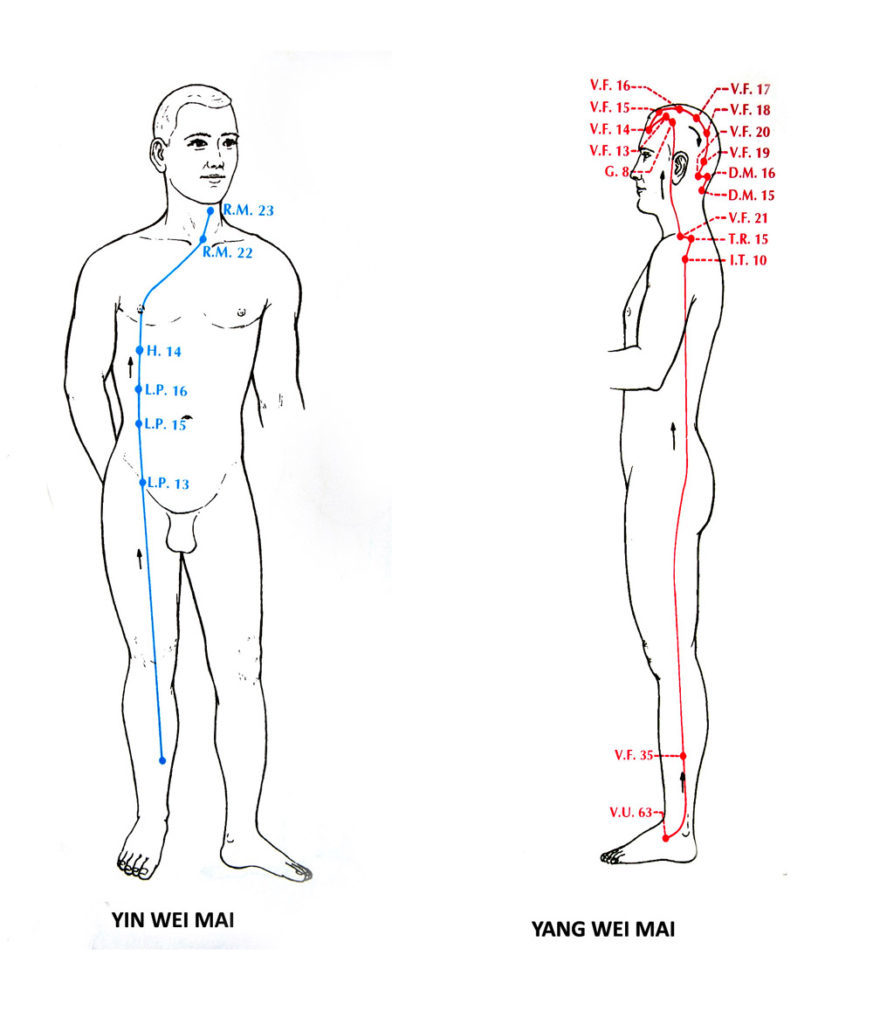
Yin Qiao Mai: the stance vessel relates to the present moment and our relationship with ourselves. The stance relates to our physical posture and anatomy as well as the way we “stand up” to ourselves. It is the way we deal with our deep fears, resentments, addictions, distractions, self-love or self-loathing. It is our relationship with our dreams, destiny, physical body as it is right now.
Carolyn Myss reminded me an important aspect of Yin Qiao Mai. In her book “Anatomy of the Spirit” Myss describes the throat chakra as the manifestation of our will. It is also a place where we surrender to spirit. The mantra she associates with the throat chakra is “not my will, but God’s will.” Yin Qiao Mai connects strongly to the throat at the acupuncture point CV-22 “the celestial chimney.” It is always fascinating how many of the ancient traditions contain information that is very similar. Myss teaches the chakra system which comes from ancient Indian traditions as well as Kabalah and Christrian mysticism. Yet the information she presents has much overlap with Chinese medicine and often brings out aspects of the acupuncture channels I’d forgotten.

I started to feel the patient’s loss of voice was a psychosomatic blockage relating to the expression of his willpower. The pain in the foot due to his inability to “fire-up” his will to express his true self through action in the world. His “bubbling spring” (the name of the acupuncture point on the sole of the foot) was blocked, failing to manifest itself in the “termination point” of the Kidney channel located at the throat.
The Chinese medical classics contain a chapter entitled “origins and terminations” discussing ways in which the acupuncture channels deposit their unresolved issues. Issues within a channel or organ can manifest at certain areas of the body. The Kidney channel, which is most closely associated with willpower and the fear that inhibits it deposits at the throat. The origin of the Kidney channel is located on the sole of the foot. Both the origin and termination area for the Kidney channel was giving the patient trouble, a very clear sign of blockage.
I shared with the patient during the treatment the philosophy of the Yin Qiao Vessel and described the Yin Wei as representing unfinished karmic business.
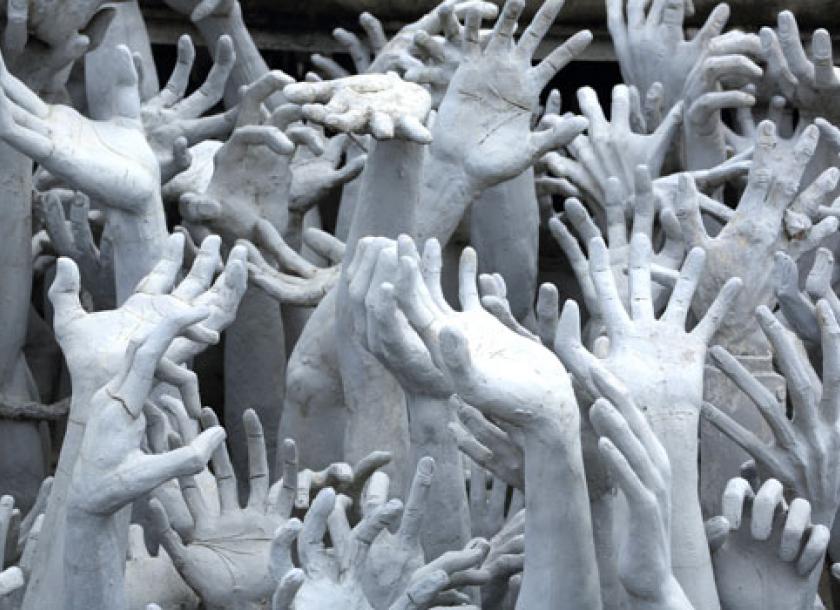
As a healer I find it helpful to play many different roles, depending on the needs of the patient. For some I’m just a doctor-clinician working on their physical ailments. For others, if need be, I act more like a therapist allowing dialogue and processing to occur. With others, who have a desire to delve into their spiritual selves, I act like the shaman or priest.
After making the invitation through discussing the philosophy of the channels the patient started talking about his own struggles with his “path in life.” He had been feeling much fear, anxiety and resistance to moving forward in his life. He would alternate between fear and apathy, which would prevent him from extending himself and developing his work and self beyond its present state. He said he felt stuck, like he was holding himself back. I asked him what he feels was preventing his movement forward. He talked about several disappointments that occurred in his past that made him “lose hope,” and fall into a state of “despair.” He’d often resort to “acting out” or obsessive-compulsive behavior to cope with his frustration.

I told him we’d begin the process of tapping into the Yin Qiao vessel, which could be somewhat like a shamanic journey. It would open passage into the unconscious. We would combine this with Yin Wei Mai which would bring us to the past and its unfinished business. The goal was to become present with his current state including his unconscious fears while we work out and resolve the unfinished business from his past.
The acupuncture points I was most interested in exploring were located at the site of his symptoms: the sole of his foot and the base of the throat.
I began by opening the Yin Qiao Vessel through the acupuncture point KI-6 located under the inner ankle. The name of this point is “Illuminating Sea.” The idea of the Sea is a gathering place of our essence: our life. The name of this point suggests the process of illumination of our nature, our life, our destiny. This point sets the tone and intention for using this channel.

The next point was KI-1 on the sole of his foot. The name of this point is “Bubbling Spring.” Rather than tell him what the point does or means, I asked him to describe it to me. He said of all the points stimulated during the treatment this one was the most powerful. It would buzz and vibrate. He described the feeling of this point as swirling energy that seemed stuck at first but later started sending itself energy up his legs into his throat and head. All the way into his eyes. He was basically describing the pathway of Yin Qiao Mai without knowing it.
I added a strong point that both gathers energy but also treats stagnations causing pain. KI-8 is called “Faith Exchange” or “Faith Gathering.” Besides for its strong therapeutic actions, the point has the ability to empower a sense of faith in oneself and one’s path in life, that is rooted in the present moment.
KI-2 on the side of the foot was also added. It is called “Blazing Valley.” This point is often see as a passage into the root fire of the digestive system. The Valley is representative of the digestive system. The blazing is the fire that fuels the digestive process. This point is adding fire movement to the rising of his “bubbling spring.”
The points on the feet were used to unblock and fire-up his own inner spark: his will to create, interact and express himself. The points on the throat and head were used to transmute his personal will into spiritual will, also allowing him to feel more spiritually connected, less alone, more aligned and therefore less afraid.
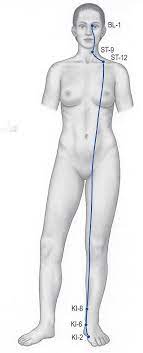
CV-22 “the celestial chimney” was used to clear his throat. This is a particular class of point called “window to the sky” which is said to empower greater perceptive awareness. These types of points help a person see the bigger picture: the more spiritual viewpoint.
BL-1 “Bright Eyes” near the eyes was also used to enhance his perceptive ability into his expressive self. This point is very powerful, having a second more ancient name: “the gate of life.” It is said to nourish the essence of one’s being. I interpret this to mean the ability to focus on the truth of oneself: to truly see oneself and honor that truth.
GB-20 “Wind Pool” located on the back of the neck was added last to expel any “wind” agitation in the form of anxiety, which can be natural side effect of “invigorating the Yang” or empowering the will.
The point ST-42 on the dorsum of the foot was added to support the rising of fluids into the throat and eyes. This is also a point that helps lift the arch of the foot.
I combined this treatment with the opening point of Yin Wei Mai: PC-6 “Inner Gate,” located on the wrist. In later treatments we also added LR-14 on the chest “the gate of completion” to further explore unfinished business that seem to be haunting him, preventing his full expression and sense of faith in his life.

I also created an herbal formula for the patient to further support his healing process. While the acupuncture focused on Yin Qiao Mai, his willpower and the present moment, the herbal formula was more Yin Wei Mai focused.
The chief herb of the herbal formula was Bai Shao (Peony) with Tu Si Zi (Chinese Dodder Seeds) and Nu Zhen Zi (ligustrum seeds). The combination of these three herbs was to nourish blood in the Liver to support the Yin (hormonal fluids) of the Kidney-Essence. This is a strategy to use whatever we have gathered in our lives to support our sense of self: our essence, the nature of our being.
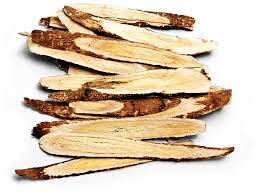
Ban Lan Gen (Isatis Root) was used to clear irritation from the throat causing hoarseness, acting like CV-22.
Gou Qi Zi (Goji Berries) were used to further nourish blood to support essence and also to nourish the eyes, much like BL-1 was used in the acupuncture treatment.
Dang Shen (Codonopsis Root), Xi Yang Shen (American Ginseng root) and Bai Zhu (Atractylodes root) were used to build Qi-energy and fluids, especially in the Lungs.
Mu Xiang (Saussurea) and Ji Xue Teng (Spatholobus Vine) were used to regulate movement of Qi (energy) and blood. There is a strategy within Chinese medicine that says whenever we are trying to build a substance (Qi, blood, fluids), we also need to move and circulate it to prevent stagnation. They go on to say that the body will often not allow anything new to be built unless the old is moved and eliminated. This prevents hoarding. Whatever we create must be used. Life is to be lived, not stagnated.
Dan Shen (Salvia root) was added to open the chest and calm the mind, acting much like PC-6 in the acupuncture treatment.
PC-6 as the “inner gate” acts like a doorway into the heart. This point is located on the Pericardium acupuncture channel though making it more a doorway into that which is protecting or shielding the heart. The Pericardium is that which holds onto the insults of life, the disappointments, “heart pains,” and lessons faced by the heart as it cultivates compassion.
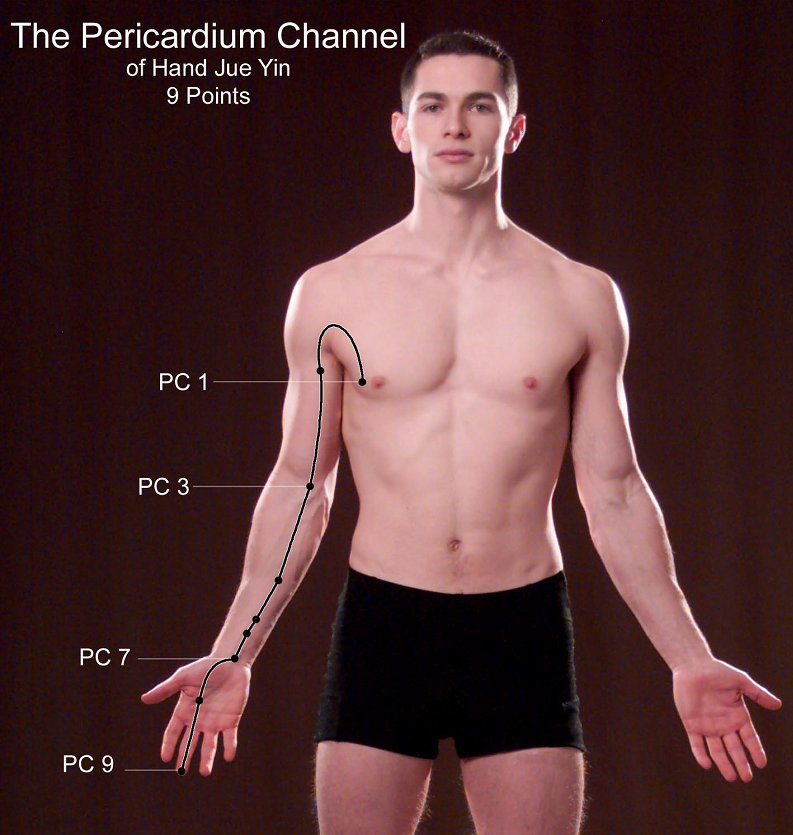
The totality of the herbal formula nourishes the self, especially the eyes to allow deeper perception of the true self. It does this through building Qi-energy and blood. It also helps to move through stagnations in thought and feeling, opening the Pericardium to deal with the remnants of the past.
Dan Shen is an interesting herb. It is said to resonate with the Pericardium, Heart and Liver. It is an herb that breaks through blood stasis, resolves “heart pain,” clears heat agitation and calms the mind. As we said the Pericardium relates to the issues held by the heart, while the Liver relates to the past: that which we’ve been unable to let go. This is the philosophy of blood stasis: experiences that we’ve been unable to process and let go of. In Chinese medicine the spirit (animation of mind and emotions) is said to circulate through the blood and be stored in the Heart. Therefore stagnation or stasis of blood means stuck experience or emotions that can become “hot” and “toxic” leading to agitation and illness. Dan Shen is modernly used as a chief cardiac health herb in many formulas.
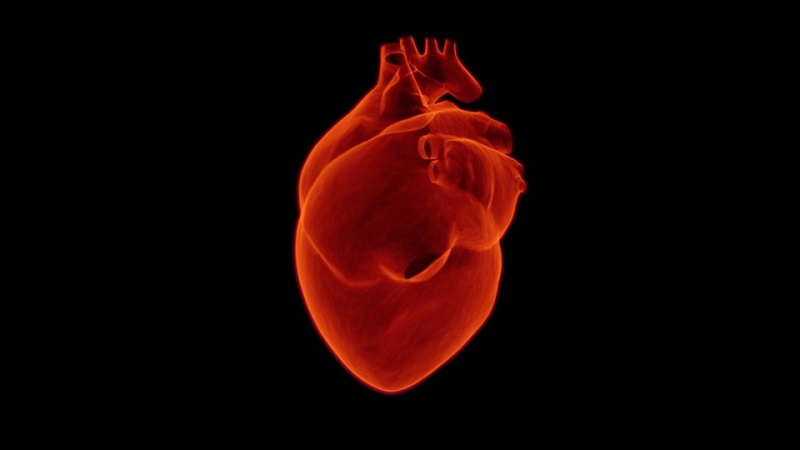
I gave the patient a prescription for 5 bags of raw herbs to prepare as a “decoction” or strained tea, as this is the strongest way to take herbal formulas. Each bag will be boiled twice (a two day dose per bag), totaling 10 days. The tea is to be consumed twice a day between meals. The acupuncture was given one time a week.
During the acupuncture sessions we began doing visualizations together, much like a shamanic journey. After the acupuncture needles were inserted, we’d mentally go into the areas that were calling to us and explore the images and sensations. I would direct the visualization journey and we’d both be surprised by what we discovered. This became a very powerful process. Much emotion was released which led to many dreams days after that illuminated much in the patient’s life and consciousness.

The intention for the healing process is very important. I often say this is what guides the process. The patient expresses their intention: how deeply they want to explore and what themes. Their pulse will also express intention. From this I choose the acupuncture channels and allow the process to unfold.
We are often alerted to an imbalance or unresolved issue through a physical symptom or a disturbance to our quality of life. This is often what brings patients into my office. Yet if I notice the pulse is expressing a quality from one of the deeper energetic layers of the body, I will direct the conversation into this area, inviting the patient to explore this level of their being. Depending on the response, and the development of intention the treatment manifests.


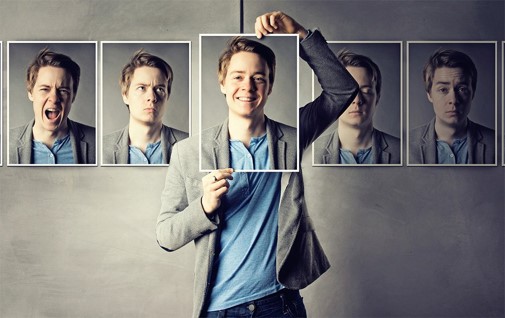

No Comments